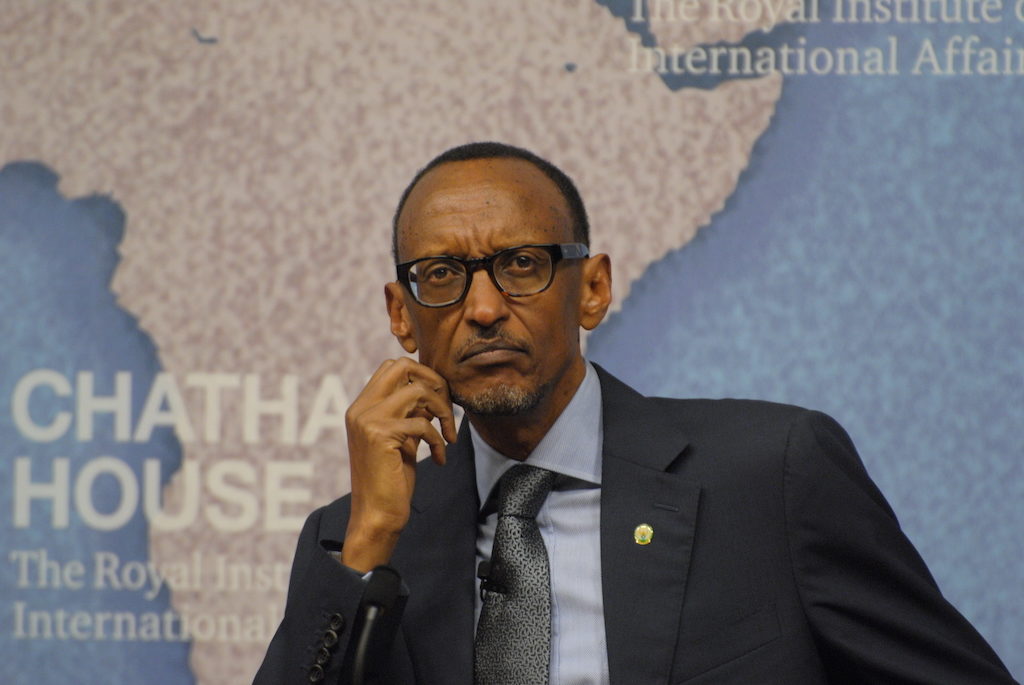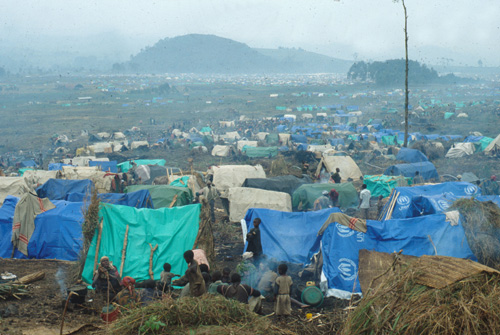Liberté, Égalité, Impérialisme! Vive la France in Black Africa! (Part 2)
TRANSCEND MEMBERS, 21 Jan 2019
Ann Garrison | Black Agenda Report – Consortium News
“Hotel Rwanda” is a touchstone of interventionist ideology. Debunking that script helps show why the closure of the assassination case against Rwanda’s President Paul Kagame serves Western interests.
10 Jan 2019 – Most Westerners believe that the Rwandan Genocide was the simple story of good and evil told in the hugely successful film “Hotel Rwanda,” but there is barely a moment of “Hotel Rwanda” that is not carefully constructed propaganda. The film was produced to convince the world that demon Hutus murdered a million innocent Tutsis in 100 days in 1994, that the U.S. and its NATO allies failed to intervene, and that their failure obligates them to intervene “to stop genocide” anywhere in the world from hereon.
Obama’s foreign policy team—most prominently Secretary of State Hillary Clinton; U.N. Ambassador Susan Rice and Samantha Power, a national security advisor—invoked the Rwandan genocide over and over, as did the press, to justify destroying Libya and beginning the aerial bombing war that continues in Syria today. The propaganda has also been used to justify Rwandan President Paul Kagame’s invasions, occupation and resource plunder in the fabulously resource rich Democratic Republic of the Congo (DRC). Western press and governments have portrayed him as Rwanda’s savior and characterized his invasions of DRC as the defense of Rwanda against “Hutu genocidaires” who fled into the DRC as he and his army advanced and seized power.
The late Edward S. Herman and his co-author David Petersen deconstructed these lies in “Enduring Lies: the Rwandan Genocide in the Propaganda System, 20 Years Later.” So did Robin Philpot in “Rwanda and the New Scramble for Africa, from Tragedy to Useful Imperial Fiction;” Marie-Beatrice Umutesi in “Surviving the Slaughter, the Ordeal of a Rwandan Refugee in Zaire;” Peter Erlinder in his compendium of primary source documents “The Accidental Genocide;” and most recently Judi Rever in “In Praise of Blood: Crimes of the Rwandan Patriotic Front.” But none of these books made bestseller lists, and none could come close to the influence of “Hotel Rwanda.”
Essential elements left out of the “Hotel Rwanda” construction include the 1990-1994 Rwandan War and massacres that concluded in the infamous hundred days. The tragedy happened over four years’ time, not 100 days, and both Hutus and Tutsis were massacred, Hutus by Kagame’s army.
Unsolved Crime
Another missing element is the unsolved crime that triggered the final bloodletting of the final 100 days: the assassination of Rwanda and Burundi’s Hutu presidents, when a surface-to-air missile downed their plane as it was approaching the airport in Rwanda’s capital Kigali on April 6, 1994. No one has ever been convicted of the crime, and there is enormous Western pressure to make sure that no one ever is. Overwhelming evidence implicates Kagame, but he is a key U.S. ally and “military partner” in Africa, and the “Hotel Rwanda” story is a key touchstone of Western interventionist ideology.
Kagame has nevertheless been accused and his inner circle indicted in both French and Spanish courts, where French and Spanish citizens claim jurisdiction because their family members died in the plane shoot-down or the ensuing massacres, but both of those cases have been shut down.
Last month, geopolitics trumped international justice again—just in time for Christmas. On Dec. 21, a French court closed the long-running case against Kagame and his inner circle for assassinating Rwandan President Juvenal Habyarimana and Burundian President Cyprien Ntaryamira, both of whom were Hutus.
Nearly 25 years later, there are still no convictions for the assassinations that turned first Rwanda, then DRC, into a vast killing ground. Not in the International Criminal Tribunal on Rwanda, where two investigations of Kagame were shut down, and where a judge told defense attorney Tiphaine Dickson, “We don’t investigate plane crashes [or Tutsis, only Hutus].” And not in the French or Spanish courts.
The Subtext: Imperial Competition
The subtext of the Rwandan War and the ensuing Congo Wars was competition between the U.S./U.K. and France. France, which was then the dominant power in the region, had been the patron of Habyarimana’s Hutu government; the U.S. and U.K. backed Kagame’s invading Tutsi army, which emerged victorious in 1994, declared that English would from thereon be Rwanda’s international business language, then invaded and occupied French-speaking Zaire (now the Democratic Republic of the Congo) two years later.
France and Rwanda have engaged in a bitter argument off and on for all these years about who was responsible for the 1994 Rwandan genocide. Their embassies have often been closed in one another’s capitals, and France pulled out of the 20th anniversary commemoration in Kigali after Kagame once again accused France of participating in the killing.
One of the recurring points of contention is Opération Turquoise, France’s emergency relief response, which began on June 23, 1994, several weeks before Kagame, then a general, seized power in Kigali. Some French officials who were in office at the time, most notably former French Foreign Minister Alain Juppé, have maintained that Opération Turquoise created a humanitarian corridor for Rwandan Hutus fleeing into Zaire, for fear of being massacred by General Kagame’s advancing Tutsi army. Kagame’s government has claimed that France instead provided an escape route for Hutus guilty of genocide, although the vast majority flooding into Zaire were civilians, including women, children, and the elderly. According to the 2010 UN Mapping Report on Human Rights Abuse in the Democratic Republic of the Congo, 1993-2003, Kagame’s troops followed the refugees into Zaire and massacred as many as 250,000.
In “Dying to Live: A Rwandan Family’s Five-Year Flight Across the Congo,” Pierre-Claver Ndacyayisenga describes how he and his family and 300,000 more Rwandan Hutus fled Kagame’s advancing army all the way through the Congolese jungle, from east to west, as many more died of hardship or were massacred by Kagame’s troops along the way.
The authors of the UN Mapping Report said that the massacres in Congo would most likely be ruled a genocide if a case were brought to court, but none has been and none ever will be without a major geopolitical shift in power. In 2013, in one of his many cynical moments, former President Bill Clinton told BBC journalist Komla Dumor that he would not condemn his friend Paul Kagame for murdering the refugees because “it hasn’t been adjudicated.” (And because it happened on his watch, with his support, as did the 1998 Rwandan and Ugandan invasions of DRC, during which Kagame and Uganda’s President Yoweri Museveni became what another UN report called “the godfathers of the illegal exploitation of natural resources and the continuation of the conflict in the DRC.”)
France Wants Its Share
France of course wants its share, and French officials now in power have decided to close the case against Kagame in order to secure access to Congo’s riches, which he significantly controls. The court’s ruling came shortly after Rwandan Foreign Minister Louise Mushikiwabo became secretary-general of La Francophonie, an international organization similar to the British Commonwealth, in what was widely perceived to be another concession to smooth French-Rwandan relations and ease France’s imperial access in DRC.
Kayumba Nyamwasa, a former Rwandan general, chief of army staff, and chief of military intelligence, was also named as a defendant in the French indictment. Speaking to Jane Corbin in the BBC video “Rwanda’s Untold Story,” he said that Kagame most definitely ordered his troops to shoot down the plane carrying the Rwandan and Burundian presidents:
Jane Corbin: Who do you believe was behind the shooting down of the plane?
Kayumba Nyamwasa: Paul Kagame undoubtedly.
JC: Paul Kagame?
KN: Oh yes, oh yes.
JC: You know that?
KN: One hundred percent.
JC: Were you at meetings where it was discussed?
KN: Well, I know. I was in a position to know, and he knows I was in a position to know. And he knows that.
BBC interjection: General Nyamwasa has offered to cut a deal with the French judge to testify.
JC: If you discuss these matters with the judge and it implicates you yourself, are you willing to do that?
KN: Obviously. If it implicated me? Why not? Because I think that truth is what matters.
The French court said they were closing the case for lack of “credible” and “significant” evidence despite abundant such evidence. That does not mean, however, that they acquitted Kagame, Nyamwasa, or anyone else who was in Kagame’s inner circle at the time Habyarimana and Ntaryamira were assassinated. As Rwandan American legal scholar Charles Kambanda said, “This is a political decision which could well be superseded by another political decision to reopen the file when there is additional ‘credible’ and ‘significant’ evidence.” In other words, France has mollified Kagame for now, but it’s kept a knife behind its back.
_______________________________________________
 Ann Garrison is an independent journalist based in the San Francisco Bay Area. She attended Stanford University and is a member of the TRANSCEND Network for Peace Development Environment. In 2014 she received the Victoire Ingabire Umuhoza Democracy and Peace Prize for her reporting on conflict in the African Great Lakes region. She can be reached at @AnnGarrison or ann@kpfa.org .
Ann Garrison is an independent journalist based in the San Francisco Bay Area. She attended Stanford University and is a member of the TRANSCEND Network for Peace Development Environment. In 2014 she received the Victoire Ingabire Umuhoza Democracy and Peace Prize for her reporting on conflict in the African Great Lakes region. She can be reached at @AnnGarrison or ann@kpfa.org .
Go to Original – consortiumnews.com
DISCLAIMER: The statements, views and opinions expressed in pieces republished here are solely those of the authors and do not necessarily represent those of TMS. In accordance with title 17 U.S.C. section 107, this material is distributed without profit to those who have expressed a prior interest in receiving the included information for research and educational purposes. TMS has no affiliation whatsoever with the originator of this article nor is TMS endorsed or sponsored by the originator. “GO TO ORIGINAL” links are provided as a convenience to our readers and allow for verification of authenticity. However, as originating pages are often updated by their originating host sites, the versions posted may not match the versions our readers view when clicking the “GO TO ORIGINAL” links. This site contains copyrighted material the use of which has not always been specifically authorized by the copyright owner. We are making such material available in our efforts to advance understanding of environmental, political, human rights, economic, democracy, scientific, and social justice issues, etc. We believe this constitutes a ‘fair use’ of any such copyrighted material as provided for in section 107 of the US Copyright Law. In accordance with Title 17 U.S.C. Section 107, the material on this site is distributed without profit to those who have expressed a prior interest in receiving the included information for research and educational purposes. For more information go to: http://www.law.cornell.edu/uscode/17/107.shtml. If you wish to use copyrighted material from this site for purposes of your own that go beyond ‘fair use’, you must obtain permission from the copyright owner.

